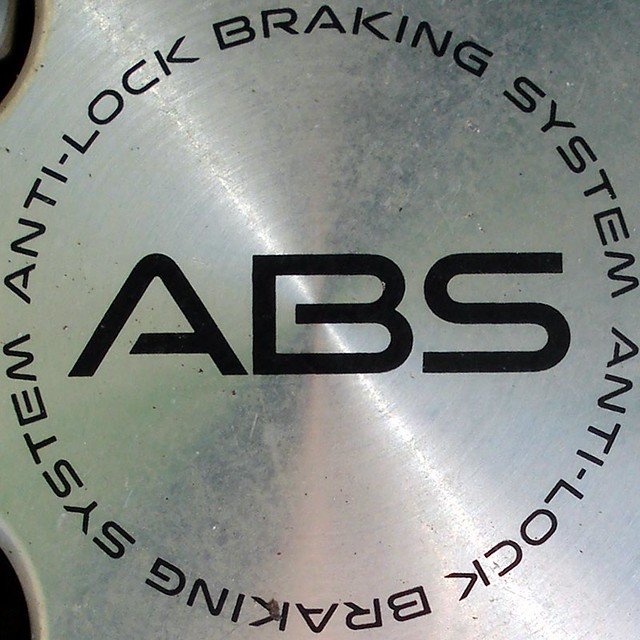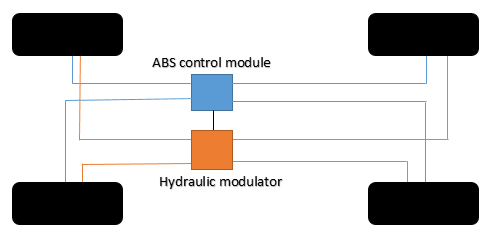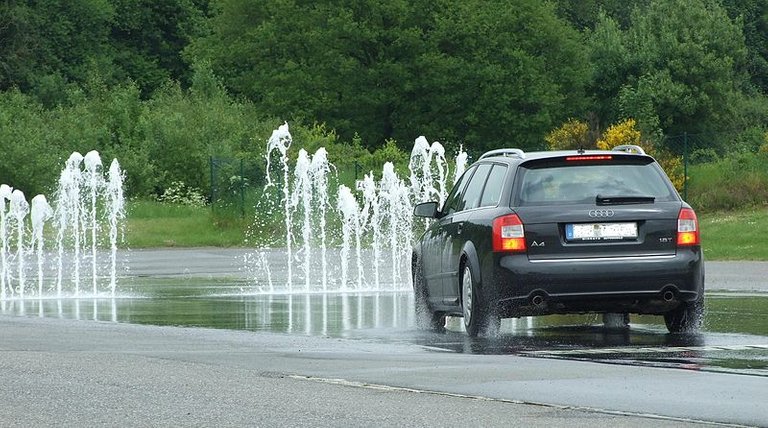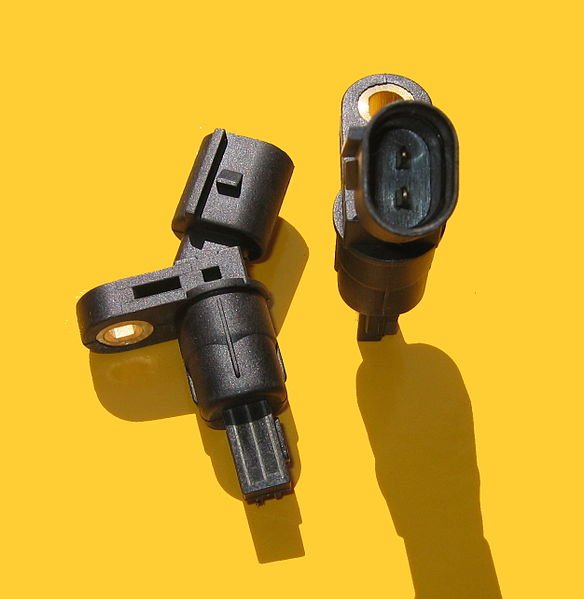Greetings to you my lovely steemians. I am delighted to be writing again. It's a new week by the way and I hope you make the best use of the time it affords you.
Today, I will be writting another automobile article and specifically a safety mechanism which resides in our vehicle but which performs it's function unnoticed. Perhaps this is due to the fact that this mechanism or feature has been around for a while now that we do not have any course to know what has existed before now for us to make reference to, say less of appreciating this innovation i am going to talk about.
I don't want you to be shrouded in suspense for long so let me reveal to you the topic with no further epistle, the Antilock Braking System (ABS).

The antilock braking system (ABS), as an added feature to the automobile conventional braking system is an unsong hero. Like I noted earlier, perhaps you do not know that early vehicles do not come with the antilock braking feature, just because for quite a long time now, all vehicles made thereafter come with this feature.
Consequently, we have come to see this knowingly or unknowingly as a norm and we do not know what it is like to drive a car without the ABS. In fact, there will be no course for us to drive a car without the ABS or any other similar system since technology will always advance as have been proved over the years.
In this article, you will understand the need for the ABS, that is, what could have been our driving experience without the ABS in our cars. We will further look at the components of the ABS as well as how they interact to make the ABS operational.
Let's take the ride

Traction, Slip and Wheel Lockup
If you happen to have a background in the science (particular physics and related disciplines), you must then be aware that friction is not a bad phenomenon afterall. For the unitiated, friction is simply the force that opposes the motion between two objects that are in contact with one another.
I have learnt during my foundational days in physics that friction causes heat, wear and tear. However, everything about friction is not just all bad, there are some things that are actually made possible by this phenomenon called friction. Grip is one which I can easily think of.
Many of our daily activities requires that we grip one thing or the other. In fact, walking is one such things that require grip. The bottom of your shoes need to have a firm grip with the ground for you to be able to walk, otherwise you will continue to skid along the road.
In fact, if you wish to make a quick alter on a slippery surface, you will obererve that it take more time becuase of have less control on the floor and you really also have to be careful so that you don't come tumbling. You will also, observe that walking is not so easy on the sea shores due to the beach and even becomes more difficult on a wet floor tile. These is due to less friction.
Whenever there's adequate friction, there will be enough grip and thus control. Such is what governs the interaction between the wheels of your vehicle and the road. The more the friction between the wheel and the road, the more the grip, this "wheel grip" is what is termed Traction.
So, why is traction needed?
Perhaps it will interest you to know that, without adequate traction, the control of the wheels is dwindled and this affects the braking. During braking, it is essential that the tire has adequate or firm grip (that is, traction) with the road surface as friction is essential for braking and control. In fact, it is the friction between the road surface and the wheel that results or ensures braking.
But what happens when there's Inadequate traction while braking?
As mentioned earlier, traction is essential for braking. When the driver applies the brakes, the tires must grip the ground well. Otherwise, the braking force will cause the wheel(s) to lock up, that is, seize rotation. In this case, we say Slip has occured. Slip doesn't have to be when the wheel completely locks up, but could also be when the rotational speed of the wheel is lesser that what the actual speed should be when there is 100% traction.
What happens next?
Remember, I have just said when slip occurs during braking, the wheel (I am targeting a wheel at a time here) will drop in rotational speed. Consequently, there's tendency for the wheel to lock up. When such lock up happens, the steering loses some of it's dominance on the wheel control and thus, the vehicle stability surfers.
By the reason of the above, the vehicle will most likely skid and this poses a safety threat. In addition, since the activity of the wheel is no more under the control of the vehicle, the stopping distance may also increase. (Don't forget that I cited a case of you trying to halt on a slippery road, that's the same thing with your vehicle)
But relax, we have a savior
At this point you surely know what I want to talk about already. Yes, the Antilock Braking system (grin: that name doesn't even have any suspense to offer).

Antilock Braking System
As you must have guessed, the Antilock Braking System (ABS) as the name implies helps to prevent wheel lockup while braking, especially when it occurs suddenly or on slippery roads where traction is always inadequate. The Antilock braking system is a safety system, because it eliminates the lockup of wheel, consequently minimizing the danger of skidding.
A careful reasoning will reveal that, the lack of steering control resulting from wheel lock up and thus skidding will prevent the car from stopping in a straight path and also increase the stopping distance - imagine what will happen when making an emergency stop without the ABS. The antilock braking system helps the driver to maintain steering control during such heavy braking so that the vehicle can be steered to avoid an obstacle or another vehicle.
But how is these possible?
The ABS does all these by monitoring the speed of each wheel relative to the other wheel and uses this information to modulate (control) brake fluid pressure as needed to control slippage and maintain traction when the brakes are applied. Tyre traction which is the measure of how the tyre grips the road surface is very important in braking as the friction generated by the braking system only keep the wheels from rotation but it is the friction between the road and the tyre that actually stops the vehicle and it allows it to be steered. If tyre traction is reduced, stopping distance increases and the directional stability of the vehicle suffers.
What makes ABS Equiped braking system different from conventional (base) braking system?
Well, the Antilock Braking system is only an add-on to the already established braking system (that is, the base brake) and it comes into play when traction conditions are not correct or during sudden panic stops when the tyre loses traction and begin to slip excessively. At other times other than just mentioned, the ABS is not involved in the braking activity - it's in the chilling mode. Consequently, having the ABS in the braking system of a vehicle does not alter the conventional maintenance procedure of the base brake. In fact, ABS are designed such that when it becomes faulty, it deactivates itself and revert to normal braking system operation.

Operation of Antilock Braking system
I have briefly hinted you on the operation of the ABS in the previous section. However, in this section, we will take a deep dive into +the ABS operation, so put on your diving suit and let's get into the bottom of this sea.
I will be doing two things simultanieously - I will be pointing out the components of the ABS along with how the ABS performs its function. Don't worry, at the end, I will give a summary for clarity.
As mentioned earlier, all antilock braking systems, controls the traction of tyres by monitoring the relative speed of the wheels during Braking. But how do we gather this Information about the wheel speed? Here is how.
Wheel Speed Sensor
To get the speed at which a wheel runs, we require a sensing device - the Wheel speed sensor. This device is installed usually on each wheel and this information is signaled to the Antilock Braking system control module (we are still coming to that). Wheel speed sensors are usually mounted in the steering knuckle(a stationary component of the suspension and steering system. They have sensor rings which may be mounted in a suitable place, depending on the manufacturer.
How does the wheel speed sensor works?
Most wheel speed sensor are of the magnetic type. They have a stationary magnetic pickup coil (which is actually the wheel speed sensor, located in the steering knuckle, working in conjuction with a rotating toothed ring installed on the wheel hub (the source of the rotation). The pickup coil consist of a permanent magnet around which a coil connected to the ABS control module is wound. As the ring rotates it cuts across the magnetic field of the pickup coil and this continuously reverses the polarity of the Magnetic field.
.png)
Consequently, an alternating current is induced in the coil. The frequency of the voltage depends on the speed of the wheel. The higher the wheel turns the higher the voltage frequency. This AC signal generated by the WSS is then sent to the ABS control module. But what do we do with this voltage signal? Let's look at that.
ABS Control Module
We have been able to generate a voltage signal based on the speed of the wheel. The signal as said earlier is then sent to the ABS control module. This device interpretes the signal received in order to carry out the corresponding response.
The ABS control module which can also be refered to as the Electronic Brake Control Module (EBCM), Electronic Brake module (EBM), Controller Antilock Brakes (CAB) module is digital microprocessor. It utilizes inputs relayed from sensors to regulate hydraulic pressure to each wheel brake while braking to prevent wheel lockup. ABS module are usually located on the hydraulic Modulator (we will look at that soon enough) assembly or it may be located elsewhere in the vehicle.
By now, it is obvious that the ABS control module obtain input from the wheel speed sensors but another sensing element which relays information to the ABS control module is the brake pedal switch. The brake pedal switch signals the control module the instant the brake pedal is depressed and consequently, the ABS switches from an inittial standby mode to the active mode.
The wheel speed sensors, on the other hand provides information about the rotation of the wheels, that is, it informs the ABS control module of the events going on within the wheels. If a wheel is observed to be decelerating faster than the other while braking or the wheels are deceleraing at a rate that exceeds the pre-set standard, the ABS control module, sends command to the Hydraulic Modulator.
But what happens within this Hydraulic Modulator? Let's find out
Hydraulic Modulator
The modulator assembly consists mainly of valves that are usually solenoid operated. These valves help to control the flow of the brake fluid (i.e. Hydraulic pressure) to the brake of each wheel according to the ABS control module requirement or command.
Let's explain what a solenoid is
The solenoid is a simple electromagnet, that is, a magnet made by applying electrical current around a ferromagnetic material (iron mostly). The solenoid consists of an Iron core around which a coil of wire is wound. When current is applied to the terminals of this coil, the iron core behaves like a magnet. Conversely, as soon as the electric current is cut, the iron core seizes to be a magnet.
But how does a solenoid actuated valve operates
As said earlier, by sending electric current to the solenoid, it behaves like a magnet. A valve is simply a gate mounted over a passage. In this case, this gate is made of a metal that can be magnetized. When the solenoid is pulsed on, the valve gate is pulled by the magnetic action of the solenoid and brake fluid is allowed to pass. Once the supply of current to the solenoid is cut, it losses its magnetism and the gate returns to the close position.
Now, Let's get back to the Hydraulic modulator
The exact number of valves per braking unit present within the hydraulic modulator depends on the particular ABS (that is, it differ from one manufacturer to the other and even from model to model) and application. Some ABS use a pair of on-off solenoid valves for each brake unit, while others use a single valve that can operate in more than one position.
So,what happens within the Hydraulic modulator?
I have noted earlier that the hydraulic modulator simply consist of valves. When the ABS control module interpretes the signal from the Wheel speed sensor(s), it sends the appropriate correction command to the hydraulic modulator (specifically to the soleonids). Consequently, the valves are pulse on and off accordingly to regulate or modulate the flow of brake fluid to the brakes.
This is equivalent depressing and releasing the pedal series of times but you should know that a computer controlled system is capable of much more frequency. In fact, the ABS is able to modulate the hydraulic pressure at about 20 times per second - think about that.
Consequently, any wheel decelerating faster than the others is brought into syncronization with the others in order to prevent lock-up. Also, in a case where the wheels are decelerating at rate faster than expected, the modulation from the hydraulic modulator, makes them revert without delay to the expected rate. Finally, as soon all standard conditions are met, the ABS goes back to being idle.
I hope you have been able to grasp the operations of the ABS, but for the sake of clarity, allow me give you a quick summary.
Quick summary
.png)
The ABS basically consists of the wheel speed sensor, ABS control module and the Hydraulic modulator.
When the conditions of the wheel(s) during braking is such that the wheel could lock-up or perhaps the wheels are decelerating (slowing down) at which differs from what is expected, the Wheel speed sensor relays this message to the ABS control module, which interpretes this message and then sends an appropriate command to the Hydraulic modulator.
The Hydraulic modulator, follows the command and modulate the flow of brake fluid to the brakes, through some valves. Consequently, the braking system is brought back to normal and the ABS goes to relax.
Time for the complement
Before I conclude this article, it is essential that I tell you few things about the ABS warning light. Not knowing about this indicator lamp doesn't affect any of the above said, but I feel this course will not be complete without it.
ABS warning Lamp
Just like every other indicator, the ABS warning lamp is a located on the dashboard on all ABS equipped vehicle. This lamp comes on whenever there's a malfunction in the Antilock braking system.
Under normal condition, all warning lamps including the ABS warning lamp should come on when the ignition is switched on. This happens for the purpose of bulb check and as soon as the engine is started, all bulbs should go off. However, if the ABS warning lamp (or any other warning lamp) stays on, there is a problem with the Antilock braking system (or any corresponding system).

What do you know so far?
The ABS is a safety feature in modern cars, which ensures that the road wheels maintain traction with the road to prevent wheel lock-up. Consequently, it improves vehicle handling and control as well as minimizes the stopping distance while braking.
It does this by monitoring the speed of each wheel during braking and whichever wheel is found to be slowing down at a rate other than the preset value, it commands it to revert to the expected condition. The ABS is capable of doing this at a rate beyond the capacity of humans - about 20 times per seconds, but could be more or less depending on the vehicle.

References
- Halderman, J. D. Automotive Technology - Principles, Diagnosis and Services. (Fourth Edition)
- Science - How Does Anti-lock Braking System (ABS) Technology In Cars Work?
- Woodward - Magnetic Pickups
- howstuffworks - Torque, Traction and Wheel slip






You have a minor misspelling in the following sentence:
It should be occurred instead of occured.hehe....
This is great sir.. I read about the abs system somewhere but i couldn't figure it out till you did this wonderful breakdown for me.. Now i can proudly say i know much more about the abs system.
I'm glad you find the post informative.
Hello! I find your post valuable for the wafrica community! Thanks for the great post! @wafrica is now following you! ALWAYs follow @wafrica and use the wafrica tag!
Visiting here has always been beneficial and ofcourse a pleasure because there is something new to learn. Lovely article
Hey man, it's my pleasure to have you here too. Thanks for reading through.
I read about the ABS sometimes ago and even though it is advantageous in many ways, it still has its own disadvantage just like every technology. The first time I drove a car with ABS, the vibration of the brake pedal almost threw me into panic :) and I have seen a colleague's car misbehaved when she marched the break suddenly at top speed.
Cars manufactured from 2002 and above are suppose to be with ABS but I'm quite amazed that mine (2003 model) isnt.
Quite some awesome analysis you did with the article. Kudos
It's a great honor to have you drop by sir. Actually the vibration you feel from the brake pedal is due to the rapid pulsation of the brake fluid by the Hydraulic modulator. Its like the system kicking you out and taking control by applying the brakes itself, but the frequency which can be around 20 times per second is the reason for the vibration. Perhaps it's not a disadvantage afterall, but instead a strange feeling.
About your car, I am not so sure why Toyota didn't install it. Probably it wasn't planned at the preliminary stages of the production of the vehicle, but subsequent models are equipped with ABS.
Thanks for being here again and for the regular support.
What else can i say? I am glad i stopped by here to learn something new even as a graduate in mechanical engineering... More power to your elbow and ink to your pen
Hey man. It's always good to have you drop by. It's been a while I read from you by the way. Please drop a post for us to read.
Thanks man!
Lolzzz..thanks for the concern bro.. Soon i will drop a post. Only that i have been having busy days. I will steam up time for one
It's alright, we all have physical activities we need to attend to. We will be here waiting to read from you.
Good reading through how ABS works, nice work brother
An informative one..Kudos!
Thanks for reading through.
This makes a standard post for whoever wants to know about the ABS. it;s just a complete guide. This is the definition of a quality post, I wish it was valued more for it worth it.
Nice work Buddy...Keep it up, I learnt a lot!
Hey man, thanks for always being sincere. Your presence here is always a motivation.
It's always a worthy read from your blog hence why I'm always coming by... Just keep doing your thing...
Thanks man!
Well written article bro. About the sensor, why haven't I seen any? Is it really not in use or it isn't seen when the automobile is in motion?
Well about the wheel speed sensor, you cannot see it easily because it's location is not obvious. It is always located in the steering knuckle and kept away from sight by the wheel.
Thanks for dropping here by the way.
nicely written sir, i don't know how i got to miss this. You really dealt with the topic although i wrote about the abs some time ago.
Thumbs up bro!
Oh really, I guess I wasn't on the platform at that time. It's good to have you go through my article. Thanks for always being here.